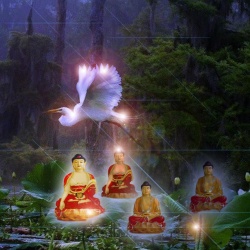Vetali
Vetali (San.) is a mahakali who has been a traditional protectress of the Practice Lineage since the time of Naropa and Marpa.
She is dark blue with red hair and four arms, wearing a skull crown and bone ornaments, seated on a saddle of human bone and a saddle cloth of human skin.
She has chains around her ankles.
She rides over a blood lake on a donkey marked with a white blaze.
She is the consort of Four-Armed Mahakala.
It is said that when Vetali lived in the realm of the gods, she was very naughty, perpetrating all kinds of pranks and generally upsetting things.
This disturbed the king of gods, as well as Yama, Lord of Death.
Trying to uphold the orderly functioning of the kingdom, they arrested this daughter of unpredictability and threw her in chains.
She escaped on the back of her donkey.
When an arrow from the pursuing armies wounded the donkey in its left hind quarter, the wound transformed itself into an eye, which represents her watchfulness to defeat any kind of obstacle to her activity.
four arms:
Vetali holds four instruments which are symbolic of her enlightened activity: skull cup, sword, mirror, and purba.
white blaze: A white marking on the forehead of her mount.
BHYO:
The seed syllable from which Vetali arises, and which expresses her essence.
yogin (San): A male practitioner; one who practices yoga, or “joining oneself” to the path of meditation.
The feminine form is “yogini.”
blood of ego: From her skull cup, Vetali drinks the blood of ego, which has been freshly slain on the spot.
sword:
A sword generally represents the sharp double edge of prajna or intellect, which cuts through the concepts of self and phenomena in one stroke. The sword does not need to strike; energies are gathered just by its being waved. Here, the sword severs the heads of those who misinterpret the teachings.
The mirror is sometimes used as a metaphor for the nature of mind, in which abides the illusory but vivid image of the phenomenal world.
three worlds: A division of the world into three levels of worldly and supramundane beings.
The highest is the celestial realm, the abode of dakinis and enlightened deities.
In the middle is the terrestrial realm, which encompasses humans, animals, and various earth-bound spirits.
The lowest is the realm of those who live underground, such as the nagas, or serpent spirits.
(Tib.; San. kila, “dagger”): This three-bladed dagger is a symbol of wrathful action which suddenly penetrates through the three kleshas of passion, aggression, and ignorance all at once, liberating them into their wisdom aspect.
mother, sister, and maid: According to the level of the practitioner’s realization, the mahakali manifests as a nourishing mother, a companion and helper, or a servant who carries out his or her activity.
lineage of Marpa the Translator
- All schools of the Kagyü lineage originate with Marpa.
The offerings are amrita, or intoxicating liquor;
the blood of the corpse of ego;
Specifically, a torma is a sculpture made out of tsampa (roasted barley flour) and molded butter, used as a shrine offering, a feast-offering substance, or as a representation of deities.
There are traditional designs for each of the many types of torma.
samaya (San.):
A vajrayana vow of commitment, binding the student’s total experience, to the path of meditation.
Samaya is the bond that links together the student, the teacher, and the teachings.
